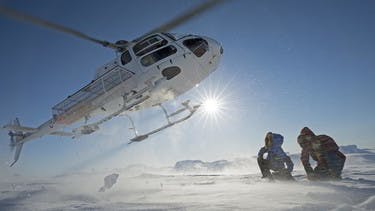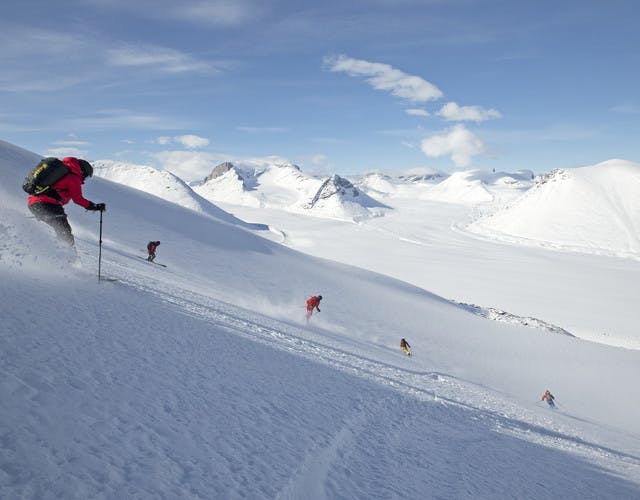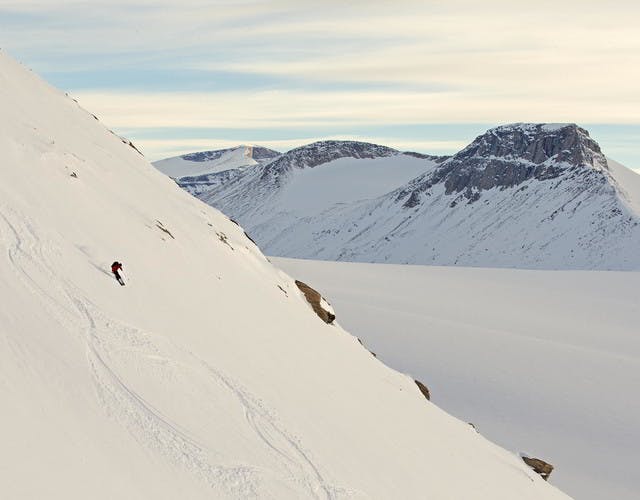
Under a blanket of snow and sea ice, the Arctic Ocean carves its way inland. Flanked by deep fjords, it ambles west following the gentle contours sculpted by the flow of ancient glaciers. From where we are at ridge top, Eglinton Fjord runs nearly 65km long, opening into Baffin Bay. 14km wide at its mouth, the fjord looks like an expansive highway of ice and snow stretching west to the icecaps above. But the eye lingers only a moment on the flat expanse. The precipitous rise of granite faces draws the eye upwards and the start relief distinguishes the fjords of Northeastern Baffin Island.

Atop an unnamed peak, 1200 meters above sea level, the cold is suspended peacefully in the windless air. The silence promotes a moment to pause. For the last few days we have skied run after run of untracked and unmarked slopes from ridge top to sea level in one of the most remote regions of the world. The landscape stretches out in front of us, treeless and without human design. Your brain scrambles to find perspective in the vast land of white and gray and understand the surreal reality of this experience. The cold brings consistently light snow that blows over your boot tops and the multiyear snow beneath holds your edges as you make turns down the 1200 meters of vertical. After years of preparation, imagination and a strong dose of determination, our inaugural year as the worlds northernmost heli-ski operation ends with smiles across the board.

Leaving Clyde River and flying to the northwest, Ayr Lake is first to appear out of the helicopter window. Once a fjord, Ayr Lake became landlocked after the glacial moraine rose above sea level cutting the fjord off at its mouth. Since the retreat of the Laurentide Ice Sheet the land in the Arctic has been rising up to a centimetre a year for the last two centuries. The product of glacial uplift, the evidence of ancient glaciers gives a sense of the sheer mass and force which has shaped this landscape.

For the past three years, Tessum, Nansen and Drew have spent several weeks each winter based on the ice of Ayr Lake & Clyde Inlet. Living in the fjord, they skied the seemingly endless lines which feed directly to the ocean. The Arctic poses unique challenges in terrain management and snowpack assessment given frequent high pressure systems, cold temperatures and challenging topography. “The snow and mountain conditions are unique to the North and need to be carefully mapped” says Drew Nylen. Over the three years of reconnaissance, the knowledge gained of the terrain and environment laid the foundation to this year’s operation. Previous knowledge had been accumulated & passed along to the trio from Richard’s 20 years of guiding in the area.

While the northern location itself poses its own challenges in launching a heli ski program, building relationships with the community of Clyde River was equally important. In Clyde River, a town of 1000, everyone wears multiple hats. The remote location demands a level of self sufficiency which is unheard of ‘down south’. Northern communities continue to live off the land (extensively) and as the ice begins to form, everyone plays their part in preparing for the upcoming hunting season. In Clyde River, the local accountant is not only a hunter but also elder and drum dancer while the gas station attendant runs the community search and rescue. Over the years, we had the good fortune to learn from members in the community and gaining their trust and support was a cornerstone in this year’s success.

Tessum explains: “The community of Clyde River is unique. The inhabitants are proud, hold strong to their cultural ways and manage to keep a healthy balance between modern and old ways. Traditional activities such as dog sledding, drum dancing, carving are still practiced Clyde River. It’s a truly special place to visit. When we first arrived in Clyde River, the community was curious of our intent. Year after year we returned, and slowly they began to see what we were trying to establish - a heli-ski operation based from the community. The biggest hurdle in polar travel is logistics - from food to fuel, accommodation, (proper Espresso!), aircraft and even just guest travel; it is all intensely harder to establish. The community was super helpful in supporting our initiative. They see the long term value of community based tourism. I remember one of the elders carefully asking me what I thought of the skiing quality; even though he’d never skied before, he say was intent on knowing the development potential of skiing. It has been a truly rewarding experience to work with these kind hearted people.”

The tenure held by Weber Arctic stretches approximately 150km from Clyde River. Fiords that hold some of the largest granite walls on earth are here; tumbling glaciers and beautifully flowing ski lines. The alien landscape is unique to Canada’s Arctic. Our season saw an international contingent skiing the tenure near daily; between 2.5 and 3 hours of flight time per day, with side trips to explore the Arctic ocean when not skiing. A land where polar bears roam, and gorgeous icebergs sit locked in the Arctic ocean ice.

Walking home in the evening, the sun sinks below the horizon but blue twilight lingers long after sunset. At this time of year, dark never takes hold of the evening sky. For northern communities, twilight is not just an hour following sunset. Rather, the pale blue light takes hold of the sky sometimes for entire days during solstice. Unique to the north, Norwegians call this period of twilight ‘blå time’ meaning blue hour. A group of kids play hockey in the glow of the evening light. Dressed in no more than just sweatshirts and jeans, the clap of their sticks in the still -20 degree temps, a reminder that we are a long way from home.
Text: Emilie Gibeau I Guide at WeberArctic





